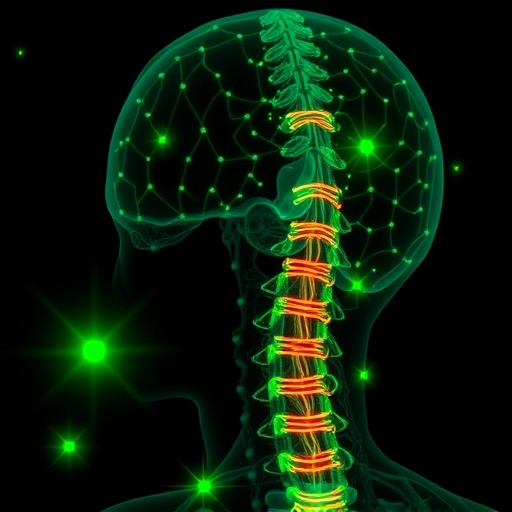In a groundbreaking study poised to reshape regenerative medicine, researchers have unveiled a novel approach to treating spinal cord injuries using exosomes derived from a unique class of human stem cells. This innovative combination could not only redefine therapeutic strategies for spinal injuries but also open new avenues in how we understand the healing processes at play in nervous system damage.
At the forefront of this research are the CD133+CD271+ human urine-derived stem cells, which have garnered attention for their regenerative potential. These stem cells represent a readily available source of cellular therapy due to their non-invasive extraction process. The researchers behind this study meticulously isolated the exosomes produced by these specific stem cells, enhancing the understanding of their therapeutic properties. This study emphasizes the promise these exosomes hold, functioning as natural carriers of bioactive molecules critical for cell communication and repair mechanisms.
Exosomes are incredibly versatile nanoparticles that facilitate intercellular communication. They carry proteins, lipids, and a variety of genetic materials, playing pivotal roles in mediating the regenerative processes. By isolating exosomes from CD133+CD271+ stem cells, the researchers aimed to harness their innate capabilities to promote healing and repair in the complex environment of the spinal cord.
The innovative aspect of this study lies in its combination of exosomes with a novel photosensitive hydrogel. These hydrogels are dynamic materials that can undergo gelation upon exposure to light, allowing for precise control over the release of the therapeutic agents encapsulated within. The synergy between the exosomes and the hydrogel creates a tailored microenvironment that can be modulated to enhance the repair processes necessary for spinal cord recovery.
In animal models, researchers meticulously documented the effects of administering these exosomes in conjunction with the photosensitive hydrogel following spinal cord injury. Initial results are promising, demonstrating significant functional recovery in neurological assessments. This combination strategy not only supports neuronal survival but also fosters neurogenesis, the process of generating new neurons, which is crucial for functional recovery post-injury.
The results stand to contribute profoundly to the field of regenerative medicine. Spinal cord injuries remain one of the most challenging medical conditions due to the limited intrinsic regenerative capacity of the nervous system. This study shines a light on the possibility of engineer regenerative scaffolds using exosomal therapy in conjunction with stimuli-responsive hydrogels, bridging the gap between cell-based therapies and the broader applications of material science in medicine.
Further investigation into the molecular pathways activated by the exosomes could provide profound insights into their mechanism of action. The study proposes that the bioactive molecules carried by these exosomes could modulate the local immune response, creating a more favorable environment for healing and regeneration. Understanding these pathways is crucial for optimizing therapeutic interventions and improving outcomes in patients suffering from spinal cord injuries.
Moreover, the findings invite a broader dialogue regarding the role of stem cell-derived products in regenerative therapies. With the continuous developments in stem cell research, the therapeutic applications of such cellular products are expanding rapidly. By showing how exosomal therapy can be integrated into treatment paradigms involving advanced hydrogels, this research enhances the appeal of stem cell-derived products for various clinical applications.
The translational potential of these findings cannot be overstated. In a world where the incidence of spinal cord injuries is alarmingly high, the search for effective treatment options is more urgent than ever. The implications of this research extend beyond just the treatment of spinal injuries; they encourage the exploration of stem cell-derived therapies in treating a spectrum of conditions characterized by tissue regeneration deficits.
As researchers delve deeper into the intricate mechanisms underlying spinal cord repair, the hope is that this study will catalyze further research and clinical trials. The prospect of an effective treatment for spinal cord injuries that could one day be routinely used in clinical practice resonates with many, igniting hope for countless individuals affected by these debilitating conditions.
This research not only showcases cutting-edge scientific innovation but also emphasizes the potential for collaboration between various disciplines. The intersection of biology, engineering, and material science is producing transformative solutions in regenerative medicine that could redefine patient care standards in the future.
In conclusion, the pioneering work by Deng, Yuan, Li, and their colleagues symbolizes a significant milestone in spinal cord injury treatment. By integrating stem cell-derived exosomes with a photosensitive hydrogel, the researchers are paving the way for novel therapeutic strategies. The findings could potentially transform how spinal cord injuries are approached and managed, offering renewed hope for better recovery outcomes and enhancing the lives of those affected by such injuries.
Subject of Research: Regenerative Medicine and Spinal Cord Injuries
Article Title: Exosomes from CD133+CD271+ human urine-derived stem cells combined with a novel photosensitive hydrogel promote repair after spinal cord injury.
Article References:
Deng, C., Yuan, F., Li, C. et al. Exosomes from CD133+CD271+ human urine-derived stem cells combined with a novel photosensitive hydrogel promote repair after spinal cord injury.
J Transl Med (2025). https://doi.org/10.1186/s12967-025-07452-9
Image Credits: AI Generated
DOI: 10.1186/s12967-025-07452-9
Keywords: CD133+CD271+ stem cells, exosomes, spinal cord injury, regenerative medicine, photosensitive hydrogel.
Tags: bioactive molecules in cell repairCD133+CD271+ stem cells researchexosomes in spinal cord injury repairhuman urine-derived stem cells for therapyhydrogel application in regenerative medicineinnovative approaches to spinal cord rehabilitationintercellular communication via exosomesnanoparticle technology in medicinenon-invasive stem cell extraction methodsregenerative strategies for nervous system damagespinal injury healing processestherapeutic properties of exosomes





